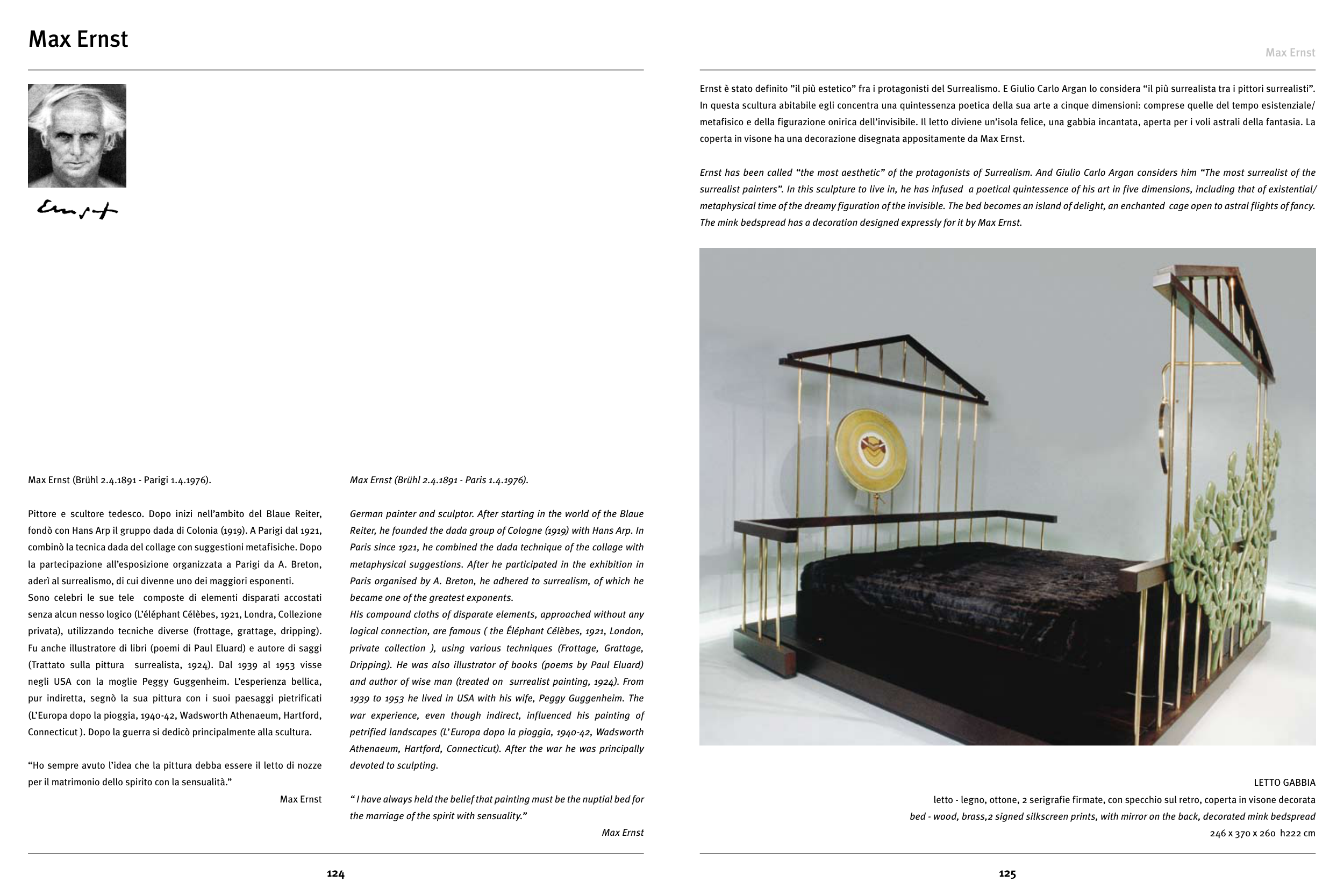LETTO GABBIA
letto - legno, ottone, 2 serigrafie firmate, con specchio sul retro, coperta in visone decorata
bed - wood, brass,2 signed silkscreen prints, with mirror on the back, decorated mink bedspread
246 x 370 x 260 h222 cm
Ernst è stato definito ”il più estetico” fra i protagonisti del Surrealismo. E Giulio Carlo Argan lo considera “il più surrealista tra i pittori surrealisti”.
In questa scultura abitabile egli concentra una quintessenza poetica della sua arte a cinque dimensioni: comprese quelle del tempo esistenziale/
metafisico e della figurazione onirica dell’invisibile. Il letto diviene un’isola felice, una gabbia incantata, aperta per i voli astrali della fantasia. La
coperta in visone ha una decorazione disegnata appositamente da Max Ernst.
Ernst has been called “the most aesthetic” of the protagonists of Surrealism. And Giulio Carlo Argan considers him “The most surrealist of the
surrealist painters”. In this sculpture to live in, he has infused a poetical quintessence of his art in five dimensions, including that of existential/
metaphysical time of the dreamy figuration of the invisible. The bed becomes an island of delight, an enchanted cage open to astral flights of fancy.
The mink bedspread has a decoration designed expressly for it by Max Ernst.
Max Ernst
Max Ernst (Brühl 2.4.1891 - Parigi 1.4.1976).
Pittore e scultore tedesco. Dopo inizi nell’ambito del Blaue Reiter,
fondò con Hans Arp il gruppo dada di Colonia (1919). A Parigi dal 1921,
combinò la tecnica dada del collage con suggestioni metafisiche. Dopo
la partecipazione all’esposizione organizzata a Parigi da A. Breton,
aderì al surrealismo, di cui divenne uno dei maggiori esponenti.
Sono celebri le sue tele composte di elementi disparati accostati
senza alcun nesso logico (L’éléphant Célèbes, 1921, Londra, Collezione
privata), utilizzando tecniche diverse (frottage, grattage, dripping).
Fu anche illustratore di libri (poemi di Paul Eluard) e autore di saggi
(Trattato sulla pittura surrealista, 1924). Dal 1939 al 1953 visse
negli USA con la moglie Peggy Guggenheim. L’esperienza bellica,
pur indiretta, segnò la sua pittura con i suoi paesaggi pietrificati
(L’Europa dopo la pioggia, 1940-42, Wadsworth Athenaeum, Hartford,
Connecticut ). Dopo la guerra si dedicò principalmente alla scultura.
“Ho sempre avuto l’idea che la pittura debba essere il letto di nozze
per il matrimonio dello spirito con la sensualità.”
Max Ernst
Max Ernst (Brühl 2.4.1891 - Paris 1.4.1976).
German painter and sculptor. After starting in the world of the Blaue
Reiter, he founded the dada group of Cologne (1919) with Hans Arp. In
Paris since 1921, he combined the dada technique of the collage with
metaphysical suggestions. After he participated in the exhibition in
Paris organised by A. Breton, he adhered to surrealism, of which he
became one of the greatest exponents.
His compound cloths of disparate elements, approached without any
logical connection, are famous ( the Éléphant Célèbes, 1921, London,
private collection ), using various techniques (Frottage, Grattage,
Dripping). He was also illustrator of books (poems by Paul Eluard)
and author of wise man (treated on surrealist painting, 1924). From
1939 to 1953 he lived in USA with his wife, Peggy Guggenheim. The
war experience, even though indirect, influenced his painting of
petrified landscapes (L’Europa dopo la pioggia, 1940-42, Wadsworth
Athenaeum, Hartford, Connecticut). After the war he was principally
devoted to sculpting.
“ I have always held the belief that painting must be the nuptial bed for
the marriage of the spirit with sensuality.”
Max Ernst
Max Ernst
124
125


